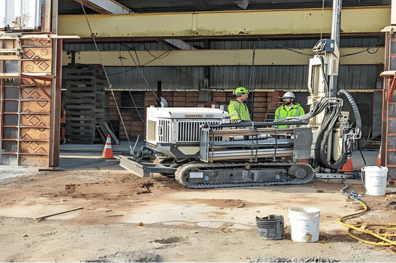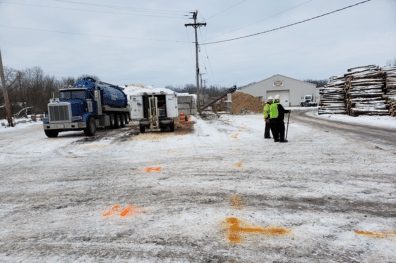ORIN successfully treated DRO and PCP contaminated soil utilizing ex-situ soil mixing. An excavator was present to displace a volume of soil down to depth. A portion of that soil was placed back into the excavation while treatment chemistry was applied to the soil. The excavator continually mixed the soil and chemicals together until the desired amount of treatment chemistry was applied. More soil was added from the displaced volume while additional chemical was applied and mixed thoroughly. This process was repeated until the desired consistency and chemical volume was applied to the entire targeted soil volume. Two areas were targeted during remediation activities. Area 1 was treated with 5,200 gallons of 17% hydrogen peroxide Fenton’s Reagent to treat approximately 316 tons of contaminated soils. Area 4 was treated with 6,000 lbs of lime catalyzed sodium persulfate treatment chemistry to treat approximately 340 tons of contaminated soils.
The Challenge
The site faced contamination from:
- Diesel Range Organics (DRO)
- Pentachlorophenol (PCP)
The contaminated soil consisted of silty sand and organic-rich silt, requiring a carefully planned treatment approach.
The Solution: Two-Part Treatment Strategy
The remediation team employed an innovative ex-situ soil mixing process using two distinct chemical treatments across different areas of the site. Here’s how the process worked:
- Excavation and Mixing Process:
- Soil was carefully excavated to the required depth
- Portions of soil were systematically returned to the excavation
- Treatment chemicals were applied during replacement
- An excavator thoroughly mixed the soil and chemicals
- The process continued until achieving optimal chemical distribution
- Treatment Areas:
- Area 1: Treated with Fenton’s Reagent
- Used 5,200 gallons of 17% hydrogen peroxide
- Treated approximately 316 tons of contaminated soil
- Area 4: Treated with alkaline-activated persulfate
- Applied 6,000 lbs of lime-catalyzed sodium persulfate
- Treated approximately 340 tons of contaminated soil
Results and Success Metrics
The project achieved remarkable success:
- PCP concentrations were reduced below the treatment standard of 120 mg/kg in both areas
- The treated soil met requirements for disposal at a Minnesota Subtitle D landfill
- Both chemical treatment methods proved effective in reducing contamination levels
Key Takeaways
This project demonstrates that:
- Different chemical treatments can be effectively used at the same site
- Ex-situ soil mixing is an efficient method for treating contaminated soil
- Proper application and mixing techniques are crucial for successful treatment
The success of this project provides a valuable template for similar remediation efforts at other contaminated industrial sites.



